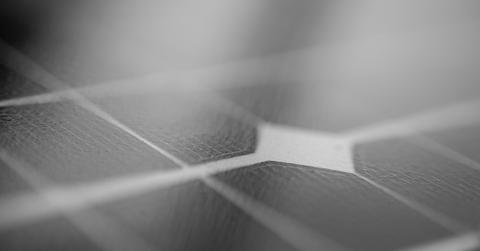New Research Offers Cheaper Alternative To Silicon Solar Cells
Technological advancements could make it even cheaper and easier to produce cells. Perovskite solar cells are easier to create and cheaper than the crystalline silicon standard, and a team at UNIST was able to reach new efficiency levels.
Updated May 24 2019, 10:23 a.m. ET
A more attractive type of solar cell could make the renewable energy far more efficient than it has ever been. While there have been reports of California generating too much solar energy, just imagine if solar panels could convert more of the sun they collect into usable electricity. Perovskite cells, which is a hybrid form of photovoltaic cells, are an alternative to silicon that are cheaper to produce and could end being much more efficient on a regular basis.
South Korea’s Ulsan National Institute of Science and Technology (UNIST) was able to set a new record of 22.1 percent efficiency with a stabilized, small perovskite solar cell. This level of efficiency was reached last year, but that wasn’t on a regular basis.
The team also achieved 19.7 percent efficient with cells measuring at one square meter. The prior record for a stabilized perovskite solar cell was set at 21.2 percent by a collaborative effort between UNIST and the Korea Institute of Chemical Technology (KRICT).
Sang-Il Seok, UNIST’s Professor of Energy and Chemical Engineering, told PV Magazine that they were able to detect flaws in the materials used in these solar cells to boost the efficiency percentage: “The key to manufacturing high-performance solar cells is to reduce defects in materials that generate energy loss when converting sunlight to electricity. Our study presents a new method that suppresses the formation of deep-level defects, thereby setting a new record efficiency for perovskite solar cells.”
Perovskite has been rivaling their more common crystalline silicon technology since last year and it continues to improve at a rapid pace. Just eight years ago, the material was only producing electricity at less than four percent. It continues to take over the solar industry by not only strong efficiency ratings, but by how it’s manufactured.
Traditional silicon cells take multiple steps to create. They need to be created in high temperatures and squeaky-clean facilities. By comparison, perovskite takes very little time to create and can be done in a normal lab environment. It’s sprayed onto the surface, which also gives it the ability to be flexible if needed.
Another advantage is keeping its high performance level even after many hours of light exposure. In April, UNIST and KRICT reported that it had a 93 percent performance rating after spending 1,000 hours in the sun.
At the moment, perovskite is still in its testing period and won’t be seen on rooftops or large solar arrays yet. Further studies, such as the ability to add layers of perovskite to make them even more efficient, are being done. Assuming the UNIST can translate larger-scale cells, the future is very bright with these efficiency ratings considering most silicon solar cells that are seen commercially can only reach around 25 percent on a stable basis.
